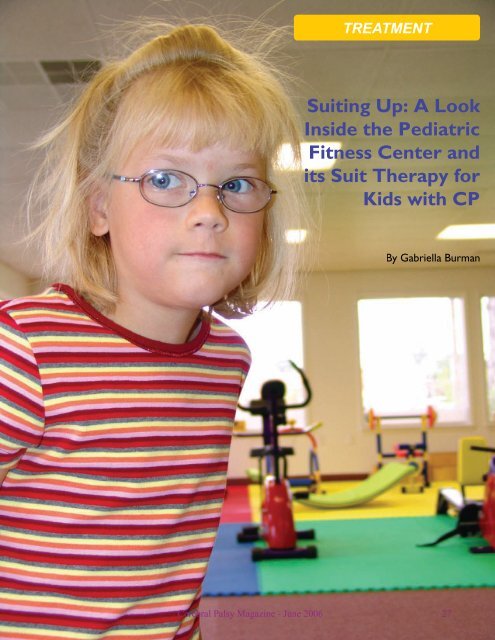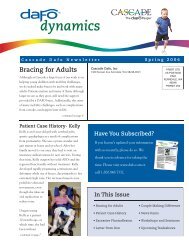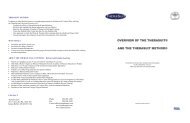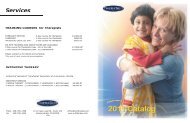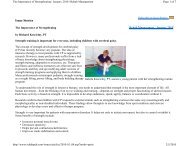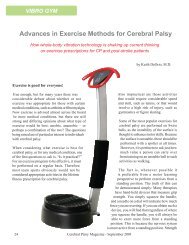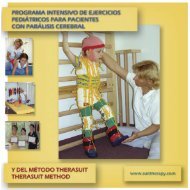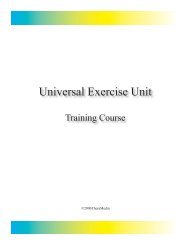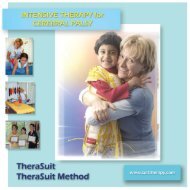Suiting Up: A Look Inside The Pediatric Fitness Center And
Suiting Up: A Look Inside The Pediatric Fitness Center And
Suiting Up: A Look Inside The Pediatric Fitness Center And
You also want an ePaper? Increase the reach of your titles
YUMPU automatically turns print PDFs into web optimized ePapers that Google loves.
TREATMENT<br />
<strong>Suiting</strong> <strong>Up</strong>: A <strong>Look</strong><br />
<strong>Inside</strong> the <strong>Pediatric</strong><br />
<strong>Fitness</strong> <strong>Center</strong> and<br />
its Suit <strong>The</strong>rapy for<br />
Kids with CP<br />
By Gabriella Burman<br />
Cerebral Palsy Magazine - June 2006 27
TREATMENT<br />
<strong>Suiting</strong> <strong>Up</strong>: A <strong>Look</strong> <strong>Inside</strong><br />
the <strong>Pediatric</strong> <strong>Fitness</strong> <strong>Center</strong><br />
and its Suit <strong>The</strong>rapy for Kids<br />
with CP Gabriella Burman<br />
For most parents, the Magic Kingdom is at Walt Disney<br />
World in Orlando, Florida, a fantasyland populated by<br />
Mickey Mouse, Cinderella and the rest of the gang.<br />
But for parents whose children have cerebral palsy, the<br />
true magic kingdom is a light-filled, one-story building<br />
in suburban Detroit, Michigan. <strong>Inside</strong>, their children may<br />
sit unassisted for the first time, transition from walking<br />
with walkers to canes, and eventually, to walking with no<br />
assistance at all.<br />
<strong>Pediatric</strong> <strong>Fitness</strong> <strong>Center</strong>, the home base for a method of<br />
intensive physical therapy called “Suit <strong>The</strong>rapy”, has proven<br />
so effective that its owners, Richard and Izabela Koscielny,<br />
have now trained more than 2,000 physical therapists<br />
worldwide, including therapists in more than 75 facilities<br />
in the U.S.<br />
Izabela Koscielny with patient CJ Gray.<br />
<strong>The</strong> suit is a modification of an “astronaut suit” designed<br />
by Russian scientists in the 1970s that restored posture and<br />
supported weakened muscles in space in order to prevent<br />
atrophy and osteoporosis in cosmonauts.<br />
In Poland, physical therapists used the Russian suit to treat<br />
adults with CP, and after the Koscielny’s daughter, Kaya,<br />
whose premature birth in Poland in 1991 resulted in cerebral<br />
palsy, took her first steps while wearing it, the Koscielnys,<br />
who are certified physical therapists, knew they had found<br />
the way to facilitate movement in children with CP.<br />
In 2002, the couple, who had moved to the U.S. in 1994, left<br />
their jobs running a physical therapy clinic at a local Detroit<br />
hospital, and set out to patent and manufacture their own suit,<br />
and open their own facility.<br />
Richard Koscielny with patient during functional exercises.<br />
28 Cerebral Palsy Magazine - June 2006
CENTER FOR CP<br />
<strong>Pediatric</strong> <strong>Fitness</strong> <strong>Center</strong><br />
<strong>The</strong>y opened the doors to their bright and cheerfully decorated<br />
center in 2003, with an office manager and themselves<br />
working as the physical therapists. In just three years, they<br />
have added six other physical therapists to accommodate<br />
the growing demand of patients who come from around<br />
the world, while also growing the business, which includes<br />
a quarterly magazine, Cerebral Palsy, and a catalogue of<br />
pediatric fitness equipment.<br />
“I never dreamt that we’d achieve all this,” says Izabela, who<br />
as the mother of a child with cerebral palsy learned early on<br />
to “take one day at a time.”<br />
“But our method caught fire because people see results in a<br />
short time and it makes parents want to take advantage of suit<br />
therapy, and makes therapists want to open a similar facility.<br />
It’s not that they were bad therapists beforehand, they just<br />
didn’t have the right tools.”<br />
Children who participate in suit therapy at <strong>Pediatric</strong> <strong>Fitness</strong><br />
<strong>Center</strong> can sign on for a three-week intensive session<br />
that lasts three hours a day, five days a week. <strong>The</strong>y work<br />
individually with the same physical therapist for the duration<br />
Universal Exercise Units in the main gym.<br />
so that a trusting relationship can be established, and progress<br />
accurately measured. Each program is tailored to the child’s<br />
specific needs and abilities, with the major goal being range<br />
of motion and strength.<br />
“Once you have strength, you can learn function,” Izabela<br />
says. “Function is the ultimate goal.”<br />
<strong>The</strong> rationale for a three-week program, Izabela explains,<br />
“is that it takes a week to stimulate the nervous system, and<br />
then two weeks to refine motor skills.”<br />
<strong>The</strong> first hour of therapy prepares the patient for the exercises<br />
that will follow. Because it is well known that the muscles of<br />
children with CP can be less vascularized, and can contain<br />
more lactic acid - which can prevent conduction between<br />
synapses and therefore prevent learning - each session begins<br />
with laying heat packs on the child’s limbs and massaging<br />
them to increase circulation and remove lactic acid.<br />
“Once we soften the tissue, and make it more flexible, we<br />
can start range of motion and strengthening, and produce<br />
movement,” Izabela says.<br />
Individual exercise room.<br />
Main gym, exercise equipement for children and teenagers.<br />
Cerebral Palsy Magazine - June 2006 29
30 Cerebral Palsy Magazine - June 2006<br />
Simon Maciejewski with patient<br />
during walking exercises.
CENTER FOR CP<br />
<strong>The</strong> next stage includes strengthening exercises. Infants work<br />
on global movements while older children work on problem<br />
muscle groups such as elbow flexors and hamstrings, often<br />
using the center’s universal exercise unit, where various<br />
weights can be attached to provide resistance.<br />
In a study of the suit, it was determined that children who<br />
received therapy five days a week wearing the suit patented<br />
by the Koscielnys achieved gains faster than those who<br />
received therapy five days a week without it. <strong>The</strong> couple<br />
recently established a non-profit entity to raise funds for<br />
further research in the hopes that a research protocol will<br />
make insurance companies more amenable to covering<br />
the cost of suit therapy. At present, the Koscielnys do not<br />
accept any insurance; parents must submit invoices to their<br />
insurance carriers for reimbursement.<br />
In some ways, the therapy can be likened to a personal<br />
training session, as the children perform squats, lunges, situps,<br />
and other exercises that strengthen their muscles for<br />
sitting, standing and walking. Often, the first day of a session<br />
passes rather easily; as the muscles waken, however, days<br />
two and three of training can be taxing on the kids, even<br />
as the trainers remain firm and encouraging throughout the<br />
session. Parents are invited to encourage and support their<br />
children, or can retreat to a quiet parents’ room away from<br />
the action to read a magazine or watch a movie. <strong>The</strong>re is<br />
also a small waiting area filled with toys and books where<br />
siblings can play or do homework while their brothers and<br />
sisters “work out”.<br />
Lower extremities strenghtening in Universal Exercise Unit<br />
<strong>The</strong> overall environment takes into account not<br />
only the needs of children and parents, but also<br />
those of the therapists who work there.<br />
Simon Maciejewski, who primarily works with<br />
older children, received training at Central<br />
Michigan University. He says working with the<br />
CP population is “more challenging” than working<br />
with patients who have other injuries, and that it is<br />
also “more rewarding.”<br />
Furthermore, he adds, he prefers dedicated work<br />
with one child to rotating through several clients<br />
a day, as he did when he worked at larger, general<br />
physical therapy clinics.<br />
“Here you get to focus on a child, and all the<br />
therapists have a true interest in what the others<br />
are doing. It’s like a family.”<br />
Functional and strenthening exercises wearing the <strong>The</strong>raSuit.<br />
Cerebral Palsy Magazine - June 2006 31
TREATMENT<br />
Dorota Jankowski (left), Kathy Howard<br />
and Mariola Vanderest promoting<br />
<strong>The</strong>raSuit during 10 k run event,<br />
Christopher Collins<br />
Sylwia and Przemek Tokarski<br />
Mariola Vanderest obtained a master’s degree in physical<br />
therapy from the Academy of Physical Education in Warsaw.<br />
She also received neurodevelopmental training on how<br />
children typically develop, enabling her to correctly align<br />
patients and stimulate proper muscle tone to help them<br />
achieve free movements.<br />
Christopher Collins is a recent graduate of Mott Community<br />
College in Flint, Michigan., and a certified physical therapy<br />
assistant who also works with older, heavier children.<br />
“At first I expected working with kids as playtime,” he<br />
says. “But it’s really intense, hard work, and the length of<br />
treatment on a daily basis is ideal in order to see results. <strong>And</strong><br />
unlike most of my classmates, I’m not juggling patients on<br />
an hourly basis.”<br />
Dorota Jankowski is a physical therapy assistant who trained<br />
at Oakland Community College and plans to pursue a<br />
physical therapy degree at the University of Michigan. She<br />
says that unlike hospital settings, where the focus can be on<br />
the bottom line, the <strong>Pediatric</strong> <strong>Fitness</strong> <strong>Center</strong> always caters<br />
to patients’ needs.<br />
“Richard and Izabela really care about kids,” she says. “If a<br />
patient is a bit late for some reason, there is no penalty. That’s<br />
rare in a physical therapy facility.”<br />
Sylvia and Przemek Tokarski are physical therapists who<br />
recently joined the team; both have vast experience working<br />
with the Russian suits that were the basis for the Koscielny’s<br />
suit therapy. In addition to working with children, they will<br />
also work with adults in the center’s 3,000 square feet of<br />
expanded space.<br />
“<strong>The</strong>re is demand from adults who<br />
want to come here, but they don’t<br />
necessarily want to work in the<br />
same space as children,” Izabela<br />
explains.<br />
Office manager Jeanne Wallace,<br />
a former physical therapist, looks<br />
forward to the additional space.<br />
“We’re outgrowing ourselves<br />
here,” she says. “Some days it’s<br />
wall to wall kids, therapists and<br />
parents.”<br />
But the volume of patients - and the accompanying hard<br />
work - is a blessing, she adds.<br />
“It’s nice to see that Richard and Izabela are realizing their<br />
dream of helping as many parents and children as possible<br />
who are affected by neuromuscular disorders.<br />
“Most physical therapy programs teach the importance of<br />
strength training, but it’s this level of intensity,” she says,<br />
“that makes the difference.”<br />
Contact inforrmation:<br />
<strong>Pediatric</strong> <strong>Fitness</strong> <strong>Center</strong><br />
2141 Cass Lake Rd., Suite 107<br />
Keego Harbor, MI 48320<br />
Toll Free (877) 843 - 7278<br />
E-mail: office@suittherapy.com<br />
www.cpfitnesscenter.com<br />
www.suittherapy.com<br />
Jeanne Wallace<br />
32 Cerebral Palsy Magazine - June 2006


